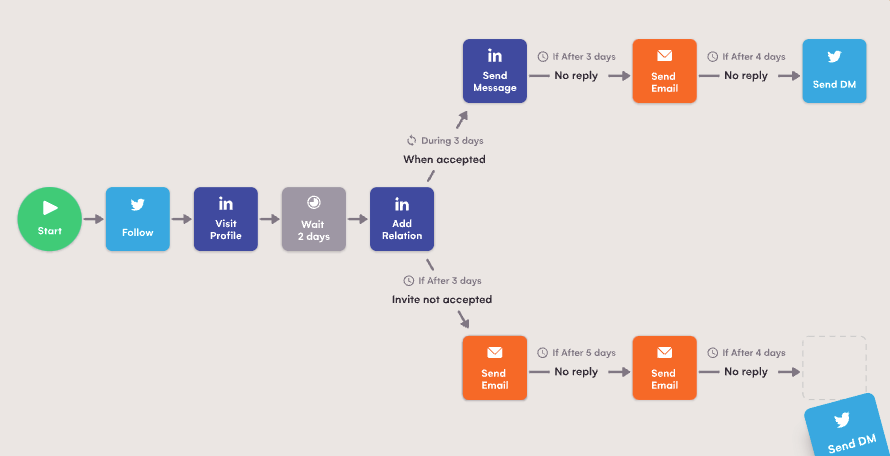Mutual Action Plans and the power of pain points (DAIC model) to close more deals
Hey - it’s Alex!
Today, I will share with you:
1️⃣ 3 actionable SaaS growth tips
👉 Unleash the power of pain points (DAIC model)
👉 Mutual action plan to close more deals
👉 Learn the difference between how the product works vs. a sales product demo
2️⃣ ‘Best tip, failure, & learning’ by Yann Sarfati (CEO at Userled)
3️⃣ 1 software tool recommendation (Lagrowthmachine)
… that will help you quickly grow your SaaS product 🚀.
👉 Before you read on:
✅ Create your own powerful SaaS Growth Strategy with my FREE Worksheet (helped 600+ SaaS professionals)
✅ Nail your Go-to-market strategy fundamentals with my FREE 1-page Notion Template (helped 500+ SaaS professionals)
✅ Unlock your growth potential with 82+ proven SaaS growth tactics (helped 100+ SaaS professionals)
1. Unleash the power of pain points (DAIC model)
Knowing the pain points of your potential customers is super relevant to your overall GTM strategy.
You need to address the pain points and the desired outcome almost everywhere - in your cold outreach, website, sales demos, and product onboarding. It’s a core element of your messaging in order to hit message-market fit.
But only knowing them is not enough anymore for a great Sales Product Demo.
Here are 4 steps to unleash the full power of pain points.
I call it the 4 steps DAIC model.
𝗦𝘁𝗲𝗽 𝟭: 𝗗𝗶𝘀𝗰𝗼𝘃𝗲𝗿 𝘁𝗵𝗲 𝗽𝗮𝗶𝗻
You need to ask questions and do a proper sales discovery to discover the pain points of your prospects.
𝗦𝘁𝗲𝗽 𝟮: 𝗔𝘄𝗮𝗿𝗲𝗻𝗲𝘀𝘀 𝗼𝗳 𝘁𝗵𝗲 𝗽𝗮𝗶𝗻
It's not enough that you know that they have a specific pain.
Make your prospects aware of the problem.
𝗦𝘁𝗲𝗽 𝟯: 𝗜𝗺𝗽𝗹𝗶𝗰𝗮𝘁𝗶𝗼𝗻𝘀 𝗼𝗳 𝗽𝗮𝗶𝗻
What are the negative implications of the problem?
What happens if they don't fix the problem?
𝗦𝘁𝗲𝗽 𝟰: 𝗖𝗼𝗻𝗳𝗶𝗿𝗺𝗮𝘁𝗶𝗼𝗻 𝗼𝗳 𝘁𝗵𝗲 𝗽𝗮𝗶𝗻
Get your prospects to confirm the pain.
So only, once your prospect is aware of the problem + knows the (negative) implications of it + not fixing it + confirms it, it's time for you to pitch your solution.
I can highly recommend applying the DAIC model to your sales discovery calls and/or Sales Product Demos.
2. Mutual action plan to close more deals
What's your number 1 lost reason?
Let me guess. It's not BUDGET or MISSING FEATURES or COMPETITION. Am I right?
Most of the time the number 1 lost reason is that your prospects DON’T DO ANYTHING.
They stick to the current solution. They maybe even go silent or ghost you.
They don't change anything.
People tend to stay where they are.
They fear the unknown.
That's why they keep what they have.
The solution: Mutual Action Plan
Your job as a founder or early salesperson is:
to make it easier for the prospect to change.
to take the decision to move to a new solution.
And to prove that the upside is big enough and that you can make their life better.
A mutual action plan is basically an alignment between you (or your sales team) and the prospect about the next steps and key milestones.
A mutual action plan will ensure:
a faster sales cycle
fewer prospects that go silent and higher buyer engagement
you always have a clear next step (and can communicate with the prospect with more confidence)
your prospect is engaged and always knows what comes next
Here are some key aspects to make it work:
✅ Make it mutual
This means that you and your prospect need to align on the next steps. It’s not enough that you outline the next steps but your prospects is not onboard. You should lead the sales process, but this doesn’t mean that you shouldn’t make sure that the next steps are also realistic for them.
Only if it’s a mutual plan, you will win.
✅ Include all relevant stakeholders
After your sales discovery, you need to know who is involved in the sales process. Make sure that all of them know about the next steps and keep them engaged. If you only deal with one person, that’s fine as long as you know who is involved in the decision-making process and you know their names and roles.
✅ Outline next steps & responsibilities
Ideally, you outline the next steps and get your prospects to confirm them.
The next steps can be something like this:
A quick discovery phone call on XX date
Product Demo with X stakeholders on XX date
14-day product test period
Product test feedback call X days after test period
Legal Check on XX date
etc.
Make sure that it’s clear to both parties who is responsible for what.
✅ Work backward with a close date and go live.
Special next steps dates are the target close date and the day to go live.
Having those dates as a mutual goal creates a sense of urgency.
3. Know how the product works vs. a sales product demo
There’s a difference between knowing how the product works and how to sell the product.
It's not the same. What's the difference? 👇
Knowing how your product works are the foundation.
You can't do a product demo without knowing how your product actually works.
But it's also not enough.
Because the goal of a sales demo is NOT to train customers how the product works (that’s a product training or onboarding session for new customers).
The goal is to show solutions to their problems and how your product will help them.
In practice this means:
Step 1: Learn how your product works
Step 2: Learn about the problems of your customers
Step 3: Connect the features of your product with specific benefits
Step 4: Connect how the benefit of a specific feature helps your customers to solve their problems.
So what you need to do is: Connect problems with features and benefits.
Once a customer has a specific problem, you need to know which feature(s) can solve the problem and what positive result/benefit it has for the potential customer.
Quick Takeaway
To sell the benefits of the feature.
You're showing features, but you're communicating values.
So don't forget to train your employees in both.
Technical understanding of your product.
Sales and communication training on how to present it.
If you can combine both, you will close more deals.
P.S. I’m working on a Sales Product Demo Playbook. Let me know if you want to get early access.
💡 Best tip, failure, and learning by Yann Sarfati (CEO at Userled)
At an early stage, your role is to be a secretary to your team and remove the barriers for them to thrive.
The biggest mistake you can make as a startup CEO is to underplay the importance of creating alignment across your team. Below are the mistakes I made.
1/ I over-owned. At my previous company, I was the owner of pretty much every decision, whether it was product or business-related, though I didn't have great engineering skills or strong product knowledge.
2/ Bringing in talents that are not ok with chaos. Startups go through very high and very low moments, the best operators are those who remain steady no matter what. In this context, having a team of people that bring good vibes to meetings and show a positive attitude no matter what is critical.
So, what should startup CEOs do?
I believe that CEOs of early-stage companies should look almost exclusively at managing alignment across their team. This is pretty much everything your role is about. Here are 4 elements to get the alignment right at your company.
Trust: Learn to trust that your team is going to deliver on their assigned tasks. You can’t constantly look over their shoulder to check that they are on track: it doesn’t bring value, doesn’t create a good atmosphere, and is a waste of your time. If you feel you are too concerned about a particular task, do it yourself
Intervention: Know when to intervene. The key here is not to micro-manage, but to create an environment where it is easy for your team to share challenges and blockers. Once a problem is highlighted, your role is to do everything in your power to remove the barrier for the person or team in charge to thrive
Don’t Overspeak: Clear and open communication is important. Yet, this doesn't mean that you need to speak every chance you get (and you’ll get loads!). Value the voice of your team over yours, and intervene only when it matters: re-aligning when things are off track.
Focus:
Maintaining focus on the team's goals and objectives is key. It sounds easy but it's not - so many distractions will come your way. Your goal is to understand what is mission-critical.
🧠 Do you want to be next and share your best tip with 750+ SaaS professionals? Reach out to me via Linkedin.
💪 1 software tool recommendation (Lagrowthmachine)
Multichannel is the way to go for outbound sales. This means combining emails, sales calls, Linkedin, and maybe even Twitter activities in your outreach sequences.
So if you want to set-up multi-channel sequences, definitely check out Lagrowthmachine - it’s a great alternative to Lemlist.
If you want to learn more about Linkedin Prospecting, check out their Ultimate Guide for Linkedin Prospecting.
P.S. Check out my list of best software tools for SaaS startups for more inspiration.
Happy growth 🚀.
TL;DR
Unleash the power of pain points (DAIC model)
Mutual action plan to close more deals
Learn the difference between how the product works vs. a sales product demo
🚀 Whenever you’re ready, 3 ways I can help you:
Follow me on Linkedin for more actionable tips to grow your B2B SaaS business
Download your FREE copy of the SaaS Growth Strategy Worksheet and unlock your growth with 82+ hand-picked, proven SaaS growth tactics.
Work with me 1:1 to grow your B2B SaaS business - send me a DM on Linkedin or book a free 15min virtual coffee with me to learn more about my offering.
Quick reminder If you like my newsletter…
… and this email is in your spam folder, please mark it as “not spam”.
… or even better, reply to this email with something like "just saying hi or some actual questions".
These are positive signals that help my newsletter land in your inbox and you don’t miss out on any future valuable info.
❤️ Enjoyed the newsletter?
Simply share it with other SaaS professionals who can benefit from it as well and click the heart icon below.





